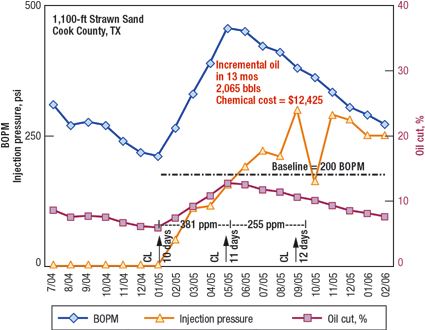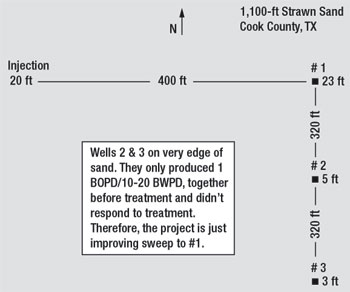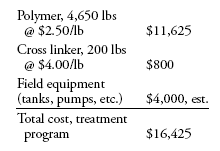|
|
|

By Petroleum Technology Transfer Council |
Low-cost, brine-activated polymer gel improves waterflood sweep
At little extra burden to its field staff, a Texas independent implemented a polymer gel process to improve a small waterflood’s sweep. Oil output quickly doubled before stabilizing at a slow decline. Conservatively, the revenue-to-cost ratio is 5.0.
James E. (Jim) Hessert, PAR Services, Bartlesville, Oklahoma
A four-well waterflood in Cook County, Texas, produces from a 1,100-ft Strawn Sand zone. This Strawn Sand is a channel sand. The injection well and producer #1 are in the main channel (Fig. 1), with more than 20 ft of sand. Producers # 2 and #3 are on the edge of the channel, with only a few feet of sand. They did not contribute much production or total fluid, either before or during this project.
 |
Fig. 1. Schematic of lease – Conformance being improved between injector and #1, located 400 ft east. Wells #2 and #3 on the very edge of the reservoir are not being influenced by the process.
|
|
In 2004, before the project began, oil production and oil cut were gradually falling, averaging 210-220 bbls of oil per month (bopm) and about 6% oil cut when the project was started in January 2005. MWS Oil Co. chose to implement a brine-activated polymer gel process, because it is low-cost and easy to implement/ monitor in the field.
THE BRINE-ACTIVATED POLYMER GEL PROCESS
The brine-activated polymer gel system is used to increase sweep efficiency in waterfloods, where matrix reservoir heterogeneity causes early water breakthrough and/or high water cuts. The process works best in reservoirs with porosities of 15% or higher, and maximum permeabilities in excess of 100 millidarcies (md). The process works by generating agglomerates of several polymer molecules in the injection brine that partially restrict injection into the high-permeability areas. This spreads injection to underflooded areas within the reservoir.
Because they are affected by high-salinity waters, the polyacrylamides that are conventionally used in polymer floods have not been effective when injected in brine. This is due to the much smaller molecular size of a polacrylamide molecule mixed in brine water. While a high-molecular-weight polyacrylamide molecule may have a size of 10 microns or so in fresh water, that same molecule will be only 1 micron in size in a typical oilfield brine.
In the brine-activated polymer gel system, the polymer is hydrated (mixed) at a high concentration in fresh water. This allows the molecule to reach maximum size before it contacts the reservoir brine. Prior to adding the high concentration polymer solution to the injection brine, it is mixed with a metallic cross-linker that is essentially inert until it reacts with components that exist in most reservoir brines. Only enough of this cross-linker is added to the concentrated polymer solution to produce the several-molecule agglomerates mentioned above.
Use of higher cross-linker levels can result in agglomerates that are too large, and that will cause formation face plugging. Because the polymer molecules are already at maximum size in the fresh water, the cross-linking prevents some of the shrinking that occurs in reservoir brines. In the rare case where brine does not contain the correct composition to trigger cross-linking, the component can be added to brine prior to contact with the polymer.
Prior to initiating an application, lab studies should be performed to find an acceptable range of polymer and cross-linker concentrations for the target application. The primary reservoir rock properties to consider are permeability and porosity. Using this process usually results in increased injection pressure. As such, the project’s surface equipment and the formation parting pressure should be considered. Good candidate floods operate below parting pressure.
This process will work with most polyacrylamides. Recommended product specification consists of polyacrylamides with molecular weights of 5 million to 15 million and anionic functionalities from 5% to 30%. In this project, the operator prepared the polymer concentrate by filling a 500-gal plastic mix tank with fresh water while adding purchased polymer into the suction of a 2-in. roper gear pump. This was done until a concentration of 5 lb/bbl of fresh water was achieved.
Tank and pump sizes should be appropriately sized to require mixing of chemicals no more than once daily. The freshwater source should be free of particulate solids and bacteria. The cross-linker, when being used, is blended into the concentrated polymer solution, only after all polymer has been added. This mixture was then pumped into a 50-bbl holding tank, before being pumped into the suction of the injection pump using a small, variable, speed-controlled gear pump. Target polymer concentrations in the injection water typically range from 100 to 1,000 ppm for most applications.
The process can be injected continuously in injection wells with high injectivities and intermittently in tighter formations. The premise is to operate injectors just below the parting pressure, keep the producers pumped down, and use the brine-gel to maintain that pressure level.
Pressure should build gradually. Severe jumps in pressure indicate too much polymer and/or cross-linker. The process can be customized easily through the varying of polymer and cross-linker concentrations, and treatment frequency and duration. The process’s simplicity allows it to be carried out with standard oilfield equipment and by the operator, himself, with minimal vendor assistance.
FIELD APPLICATION
In this application, the concentrated polymer solution was mixed at 5 lb of polymer/bbl of water using fresh water from an on-site well. The initial target polymer concentration in the injection stream was 400 ppm, and actual operations over the initial few months achieved an average concentration of 381 ppm, Fig. 2. Beginning in mid-June, the target polymer concentration was decreased to 250 ppm, and 255 ppm was actually achieved. Concentrations and timing of when the concentration was changed were based on laboratory tests and previous experience.
 |
Fig. 2. Performance plot – Oil production responded within weeks, doubling within four months and is now declining in a stable manner. Injection pressure built steadily over eight months to the target level and has remained in that range.
|
|
Concentration and volume of the initial cross-linker slug (50-100 ppm for 10 days) were also based on lab tests and experience. From then on, injection pressure response was the primary consideration that influenced the timing of two additional cross-linker slugs (11 days in May, 12 days in September). In this case, the last cross-linking reached the injection pressure goal and the designed polymer slug volume when polymer was stopped.
Oil production responded within weeks, doubled within four months to a peak of about 450 bopm, and has since exhibited stable decline. Production does not always respond this quickly. If more wells are involved, and the reservoir is not a channel sand, response is often slower. Incremental output through February 2006 is estimated at 2,065 bbl, using 200 bopm as a conservative estimate of baseline production. At current oil price levels and fluid volumes being handled, the economic limit is in the 60-to-70-bopm range, confirming that measurable, incremental oil still remains to be recovered.
PRODUCTION/ECONOMIC RESULTS
Total project cost was just over $16,000. Of that total, 75% is for polymer and cross-linker. Cost does not include additional operator time, but that was minimal, being only 5 to 7 hr per week for polymer mixing and process monitoring.
Using a $40/bbl oil price, a deliberately conservative value that PAR Services uses to screen projects today, the ratio of gross revenue to total cost (excluding labor) is 5.0, confirming a quick payout and attractive economic performance from this simple-to-implement process. 
ACKNOWLEDGEMENT
The author and PTTC would like to thank Glenn Miller with MWS Oil Co. for agreeing to share their field performance data.
THE AUTHOR
|
| |
James E. (Jim) Hessert, owner of PAR Services (Polymer-Augmented Recovery Services) in Bartlesville, Oklahoma, founded the firm in 1986. PAR Services specializes in polymer flooding, improved waterflooding, water reduction treatments and casing leak squeezes. He began his oilfield career with Phillips Petroleum, developing chemical EOR technologies and received 34 patents there. Still specializing in chemical EOR, Mr. Hessert worked stints with CORT (Custom Oil Recovery Technology) and American Cyanamid. He studied chemical engineering at The University of Tulsa. He can be reached via email at: OKTruth@aol.com
|
| |
|
|





